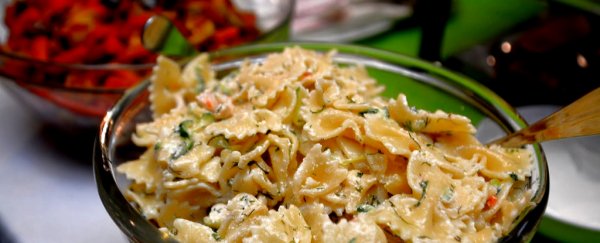If meat is left out on the counter for too long, we all know we need to throw it out. But what about rice or pasta?
Although that carby goodness might seem harmless after sitting on the bench for a bit, you'll probably think twice about it once you hear about the bacterium Bacillus cereus.
It's not a particularly rare germ. B. cereus will happily live wherever it can – soil, food, or in the gut.
"The known natural habitats of B. cereus are wide-ranging, including soil, animals, insects, dust and plants," Anukriti Mathur, a biotechnology researcher at the Australian National University, explained to ScienceAlert.
"The bacteria will reproduce by utilising the nutrients from the food products [..] including rice, dairy products, spices, dried foods and vegetables."
Some strains of this bacterium are helpful for probiotics, but others can give you a nasty bout of food poisoning if given the ability to grow and proliferate - such as when you store food in the wrong conditions.
The worst scenarios can even bring death.
In 2005, one such case was recorded in the Journal of Clinical Microbiology - five children in one family got sick from eating four-day-old pasta salad.
According to the case study, pasta salad was prepared on a Friday, taken to a picnic on Saturday. After coming back from the picnic it was stored in the fridge until Monday evening, when the kids were fed it for dinner.
That night the children began vomiting, and were taken to hospital. Tragically, the youngest child died; another suffered from liver failure but survived, and the others had less severe food poisoning and could be treated with fluids.
"B. cereus is a well-known cause of food-borne illness, but infection with this organism is not commonly reported because of its usually mild symptoms," the researchers explain.
"A fatal case due to liver failure after the consumption of pasta salad is described and demonstrates the possible severity."
While these deaths are mercifully rare, they have been recorded in the literature more than once. Another case published in 2011 tells the story of a 20-year-old student in Belgium who would prep his meals for the week – on that fateful occasion, it was spaghetti with tomato sauce.
He'd cooked the pasta five days earlier and would heat it up together with sauce. That day, he accidentally left his food on the kitchen bench for an unspecified amount of time. After diarrhoea, abdominal pain, and profuse vomiting, he died later that night.
A reply to this case study highlighted two more cases of young people who suffered liver failure and died from B. cereus - an 11-year-old who died after eating Chinese noodles, and a 17-year-old who died after eating four-day-old spaghetti.
Now, before you swear off pasta for life, we need to stress that most people who get sick with B. cereus do not end up having liver failure. Usually, it's a pretty mild case of food poisoning.
"It is important to note that B. cereus can cause severe and deadly conditions, such as sepsis, in immunocompromised people, infants, the elderly, and pregnant women," says Mathur.
"[Most] affected individuals get better over time without any treatment. These individuals do not go see a doctor to receive a diagnosis," and therefore they are under reported.
But how can it cause such severe food poisoning, and is there anything we can do?
B. cereus has a bad habit of secreting dangerous toxins in food. Some of these toxins are really hard to kill with the heat your regular microwave would deliver.
For example, one of the toxins which causes vomiting in humans (called an emetic toxin), can withstand 121°C (250°F) for 90 minutes. And that's not the only toxin you'll find in its arsenal.
"Our immune system recognises a toxin [haemolysin BL] secreted by B. cereus, which leads to an inflammatory response," Mathur explains, talking about a research study on the bacterium she co-authored last year.
"Our research study shows that the toxin targets and punches holes in the cell, causing cell death and inflammation."
Her team also identified two ways we can help the body neutralise the effect of haemolysin BL, therefore stopping the death march of B. cereus. The methods involve either blocking the activity of the toxin, or reducing the inflammation caused by it.
Although their approach is still in the early stages of research, the team hopes that these techniques could even be used in other toxin-producing bacteria, such as E. coli.
But most importantly – keep your food in the fridge and practice good kitchen hygiene.
"It is important for people to wash their hands properly and prepare food according to safety guidelines," says Mathur.
"Further, heating left-over food properly will destroy most bacteria and their toxins."
The research has been published in Nature Microbiology.
A version of this article was first published in January 2019.
